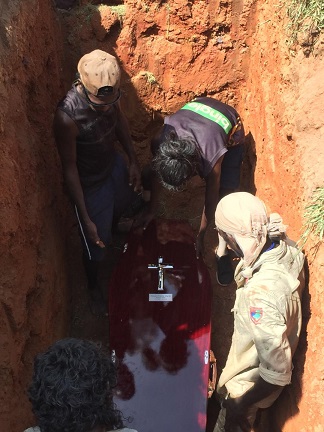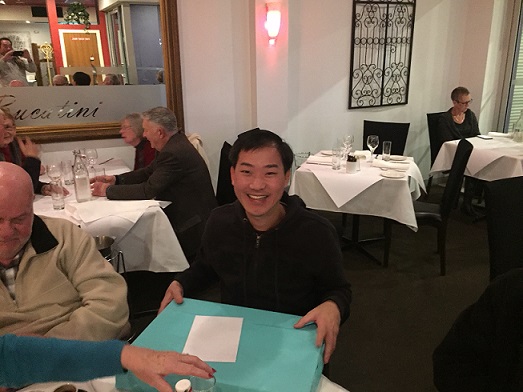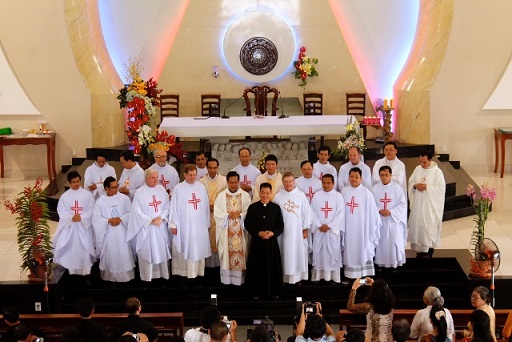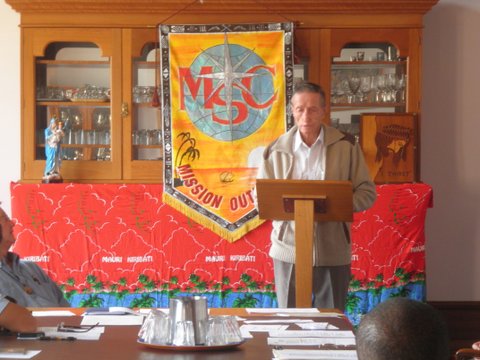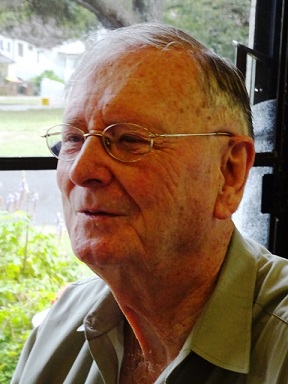Peter MALONE
SOME SIGNIFICANT MAY DAYS FOR THE CHEVALIER FAMILY 2020
SOME SIGNIFICANT MAY DAYS FOR THE CHEVALIER FAMILY 2020
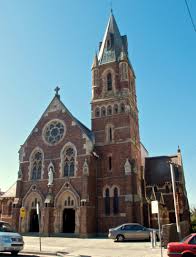
A reminder, May 6th, that the Church of Our Lady of the Sacred Heart in Randwick was opened in 1888, only a few years after the arrival of the first MSC in Sydney. The parish in those days extended to Botany.
1 May, 1863
An article on Our Lady of the Sacred Heart appears in the Jesuit publication, "Messager du Sacré-Coeur", founded by Fr. Henri Ramière, SJ. It is the first presentation of this new title for Mary.
3 May 1928
Mother Liboria Loeper, Provincial of the American Province MSC Sisters, arrived in Sydney to begin an Australian foundation that would be of support to the established Mission in Papua New Guinea.
6 May, 1883
The shrine of Our Lady of the Sacred Heart at Sittard, Netherlands is elevated to a Basilica by Pope Leo XIII. Today, it is the National Shrine of Our Lady of the Sacred Heart in the Netherlands.
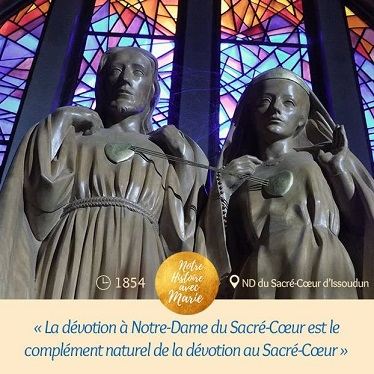
6 May, 1888
In Randwick, Australia, the church built by Father Michael Tierney, is dedicated to Our Lady of the Sacred Heart. Today, it is the National Shrine of Our Lady of the Sacred Heart in Australia.
10 May, 1888
The first MSC Fathers Edouard Bontemps and Joseph Leray, and Brother Conrad Weber arrive in Kiribati! Fr. Leray would later become the first Bishop of Gilbert Islands.
12 May, 1931
Father Eugène Meyer dies in Issoudun. He was the Superior General of the MSC from 1905 to 1920, the second after Father Jules Chevalier.
14 May, 1926
Father Pierre-Marie Tréand, founder and first Provincial of the Australian MSC Province, dies this day.
8 May, 1856
Still early days of the MSC foundation. Father Charles Piperon joins the budding community of the Missionaries of the Sacred Heart, in Issoudun. Two days later, the Archbishop of Bourges appoints him as Prison Chaplain at Issoudun.
21 May 1928.
At Station Pier, Melbourne, she welcomed Srs Eulalia, Aquilina, Maurilia, Zaccharia, and Margareta. Their first destination was Rupertswood, Sunbury where they provided practical support to the Salesians.
22 May, 1839
Jules Chevalier is 15 years old. On this day, he received the sacrament of Confirmation at Richelieu. He received his First Holy Communion three years earlier on 29 May, 1836, again in Richelieu.
26 May, 1860
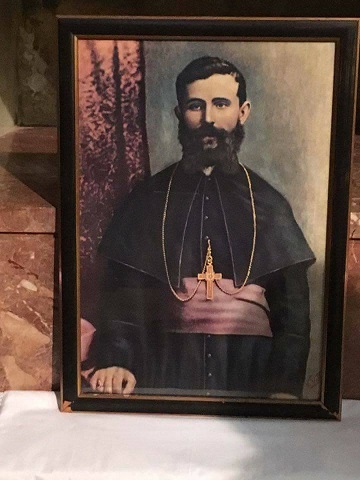
Henry Verjus is born in Oleggio, in Italy.
31 May, 1865
The feast of Our Lady of the Sacred Heart is publicly celebrated for the first time.
By 1872 the feast is celebrated worldwide in 950 churches or chapels.
For quite some time, this feast was held on this date, but today, globally, the feast is observed on the last Saturday in May.

THE HEART OF LIFE CENTRE, MOVE TO MALVERN, COVOID-19, REPORT
THE HEART OF LIFE CENTRE, MOVE TO MALVERN, COVOID-19, REPORT
The Director of Heart of Life, Paul Beirne, makes a report on what has happened at Heart of Life, the first months of 2020.
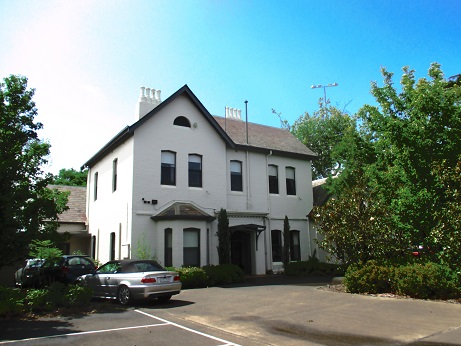
HEART OF LIFE
Centre for Spiritual & Pastoral Formation
__________________________________________________________________
The Vicarage
St Georges Anglican Church
296 Glenferrie Rd
Malvern 3144
Email This email address is being protected from spambots. You need JavaScript enabled to view it.
Website: http://heartoflife.melbourne
On 3rd of October, 2019, at the Transitus of St Francis liturgy, I was informed by the Franciscan Provincial that the lease on the premises we were occupying was not being extended and we would have to evacuate the premises in the near future. He informed me, however, that a space had been set aside in the restructured St Francis monastery for Heart of Life, and he invited me to view this space the following day, an invitation which I accepted. Several members of the Heart of Life staff also inspected this possible new location, and in the end, in consultation with the MSC Provincial and Provincial Council, we made the decision not to take up the Franciscan’s offer. This meant that within a very short window of time we had to find a new location for Heart of Life, pack up all our belongings, including the Library, clear out the premises, and move to a new location in time to welcome returning and new students on 7th February, 2020.
Without going into the complexity, or the drama, of this challenge, we did manage to find a place to move to—The Vicarage, at the rear of St Georges Anglican Church in Malvern. We were made to feel very welcome by the Wardens and Council members of St Georges who made every effort to accommodate their new neighbours, and to make us feel at home. There was one codicil to the agreement however, which offered a significant challenge--the lease of The Vicarage would be for just one calendar year, a duration during which the St Georges Council would be planning a future development of The Vicarage. Consequently, Heart of Life’s search for a permanent home continues.
In order to make the move from St Paschals, a rallying call was sent to the graduands from previous years, who were very generous with their time and efforts. They came, packed, discarded and cleaned—we could not have done without them. Special mention must be made to the St Paschal’s Library Manager, Miranda Fifield who, together with Associate Librarian Nick Gellatly and Library Officer Ben Ross, who packed the Heart of Life Library into dozens of catalogued boxes, helped stack them onto the moving van, and installed them meticulously in what became the Heart of Life Library on the first floor of The Vicarage. An amazing effort indeed, which further establishing our close operational link with the St Paschal Library.
In the midst of all the activity of packing, moving and relocating, and in coordination with the MSC Provincial Chris McPhee, a Heart of Life Summit was convened on 23rd January to consider the future of Heart of Life, or indeed, whether or not it had a future at all. One consequence of the challenges that Heart of Life faced was that, as Director, I cancelled the intake of new students who had applied for Part Time 1 of the Siloam course, on the grounds that, it is a two year course, there was no guarantee that Heart of Life would still be in existence to offer them the second year of their course in 2021. Things were that serious. As Director, I also compiled a seven-page Position Paper which outlined the past, present and possible future of the institution, which contained the very real possibility that Heart of Life would not be in existence after the current year.
The meeting comprised the MSC Provincial, members of the MSC Provincial Council, members of the MSC Formation Team, and representatives from Heart of Life and was ably chaired by Rev Dr Peter Bentley from WellSpring Spirituality Centre who is also a lecturer at Heart of Life. The outcome of the meeting is summarized as follows by the Director:
“The Heart of Life Summit concluded at 4pm. There was unanimous agreement among participants that the day had not only been worthwhile, but had outlined a blueprint for the future of Heart of Life that is encouraging, practical, and far-reaching, built around 9 very specific recommendations. It also outlined key decisions that have to be made by mid-2020. I think it is safe to say that the attendees at the Summit were energized by its discussions and outcomes, and, even with challenges ahead, are united in confidence about the future.”
The move was completed on Thursday 6th February, the day before the students were arrived. Orientation was completed the following week, and classes began the Monday after that. The staff of Heart of Life, confident that we had managed to at least subdue if not to tame the whirlwind, began to relax a little in the knowledge that we had at least 4 months until the next phase of the search began.
“Phew” we sighed collectively, “What else could possibly go wrong?”
Then COVID-19 struck!! We closed everything down at The Vicarage on 23 March, vacated the premises, and now all teaching, learning, supervision and communication is conducted via ZOOM.
What does the future hold for Heart of Life?
Watch this space!!
Director
AN OLSH SISTER'S STORY. FROM THE OLSH RANDWICK PARISH BULLETIN. SISTER MARY RUTH.
AN OLSH SISTER'S STORY. FROM THE OLSH RANDWICK PARISH BULLETIN. SISTER MARY RUTH.
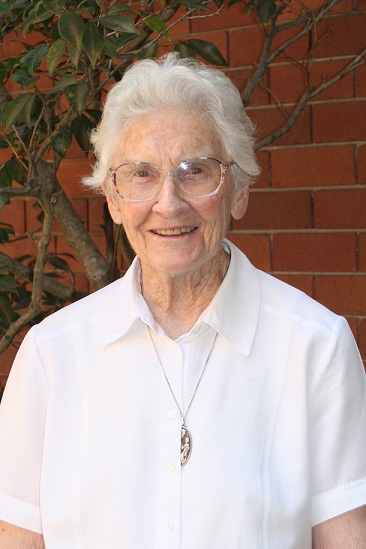
FROM A GRATEFUL HEART – A GLIMPSE OF MY LIFE.
My story begins by saying that never in my wildest dreams could I have imagined the various paths my life would take. It has been enriched by my family, children, students, families and people, OLSH sisters, MSC Priests and Brothers of many nationalities both here and in PNG.
I have been given so many opportunities which made a wonderful difference in my life; to my attitudes, my ability to do things, the strength to cope with difficulties, challenges, mistakes, the courage to go ahead and the joys and happiness experienced. Above all, God’s grace and my Family, Faith and Vocation. I am full of gratitude.
First is my family. My parents were English, my Father- half French. Both families emigrated from England in the early 1920’s. When married they lived in Adelaide where I was born and also my brother. A few years later we moved to Melbourne and my sister and another brother were born. We had a very happy Catholic upbringing, with loving and wise parents. It was from them that we had an understanding and love of the Sacred Heart and Our Lady of the Sacred Heart, which was the Charism of the Daughters of Our Lady of the Sacred Heart who educated me in Primary School and early Secondary.
They inspired me especially when talking about their Mission, to make the love of God known everywhere. During these years the seed of my vocation was sown. The family moved and I completed Senior High School with the Brigidine Sisters. Then I worked for my Father in his Accountancy Practice in the City and was very active in my Parish; I was a member of the Children of Mary group, I played tennis and basketball, enjoyed the socials and various outings of our mixed Youth group.
With the blessing and support of my parents I left home in November 1950, a few months before my 18th Birthday and entered the Novitiate of the Daughters at Hartzer Park near Bowral. Professed in 1952 I went to the Motherhouse in Kensington, here I completed my Teacher Training. I taught for a year in Adelaide and 18 months at OLR School Kensington.
Then, to my great joy I was “Missioned” in July 1956 to Port Moresby PNG, a new country and a new culture. I joined our Sisters experiencing a very homely community atmosphere and taught in St. Joseph’s Primary School. The Community leader was a wonderful missionary and for me, a great mentor.
In 1962 I had the great privilege of being chosen to join a Priest and another sister when
a Catholic mission was established in a non-Catholic district about 113 kms from Moresby. This was real pioneering work and probably the greatest experience of my religious life. The beginnings were small, a school was opened, people asked to be instructed and were Baptised, the sisters began health clinics, nearby and faraway villages were visited, and new outstation schools were opened.
In some villages visited it was the first time that the people had seen European women, let alone a Nun.
During the following years I was involved in Primary schools, Principal of a girls boarding school at Vunapope, near Rabaul and then a lecturer in our Teacher’s College for women. Later I was at a Mission Station a long way from Rabaul, our only contact with the outside world was mainly via two-way radio. Here I had the opportunity to visit our teachers in 2 other schools in the Parish, to help and support them in their more isolated situations.. Once a year we went to Vunapope for our Retreat. As a teacher I was aware of the great opportunity and privilege given of influencing the lives of so many students from all over the country and the immeasurable richness added to my life through this contact with them and their families.
A change of apostolate occurred when I was asked to be involved in the formation of young women aspiring to religious life. First I became Novice Mistress in the Indigenous Congregation of the Daughters of Mary Immaculate, the first local order founded by Bishop Louis Couppe msc at Vunapope in 1912.This was very special. After 5 years I was able to pass this responsibility to one of their own Sisters. Then I was involved in the formation of our own Postulants who mainly came from areas where our sisters were. Again after 5 years I was happy to hand this work to a PNG sister.
For health reasons I had to leave PNG. Little did I know that I would not return. But as always, God had his own plan for my life, so in 1996 I officially became a member of the Australian Province after 40 years away. Reinserting myself back into this culture, was much more difficult than I had found going to PNG.
My first community was where I had grown up. I was involved in Parish ministry, which I loved and had the added joy of reconnecting with my family of whom I had not seen much whilst in PNG. I was given the opportunity to go to Issoudun in France, the birthplace of our Congregation, for a Renewal Seminar, a most special time. I also visited Rome, my Grandfather’s relatives in the south of France, and Holland where I reconnected with the Dutch sisters with whom I had lived in Rabaul. For 5 years beginning in 199I I was on the staff at our Retreat/Conference Centre Harzer Park, with its special apostolate. I also became the contact sister for our Associates in Canberra who met each 1st Saturday of the month. I continued this for 17 years altogether. This was a grace for me, for I witnessed their dedication to their families, their vital involvement in their Parishes and their outreach to others as they lived out our shared Charism ‘to be on earth the Heart of Christ’.
Then a change to join the community at St. Joseph’s Aged Care Facility in Kensington for our elderly sisters and MSCs. In 2005 I was called to a Community in the main house. Then in 2011 two of us moved into the OLSH Parish in Randwick, It was a great privilege to be part of this Faith community and especially to be involved for the special Holy Hour each Tuesday, the permanent Novena of Thursday at Our Lady’s Shrine and leading groups on special visits. Although I have moved back to Kensington I am still involved in the parish and the interaction with the Parishioners keeps me well grounded in the reality of life outside the Convent.
I returned to PNG in 2010 for the 125th anniversary of the arrival of the first missionaries at Yule Island, in 2012 for the Centenary of the Daughters of Mary Immaculate, and in 2014 for the 100th anniversary of St. Joseph’s School.
I am so grateful for the sisters with whom I have lived and who have influenced my life. I have never doubted God’s mysterious call to belong to Him. The Mass, the Blessed Sacrament, Our Lady’s special place, Community and personal prayer have been the “essentials”. The good Lord has been with me thus far and tells me, ‘All shall be well and all manner of things shall be well’
APPOINTMENT: VOCATIONS, AUSTRALIAN PROVINCE: THANG NHU NGUYEN MSC
APPOINTMENT: VOCATIONS, AUSTRALIAN PROVINCE: THANG NHU NGUYEN MSC
On Friday May 1st, Thang Nhu Nguyen will begin his appointment as Vocations Director. He will be based at St Brigid’s Coogee Presbytery.
Thang made his profession in Vietnam, 2008, and was ordained in 2016.
From the archives.
Final Profession.
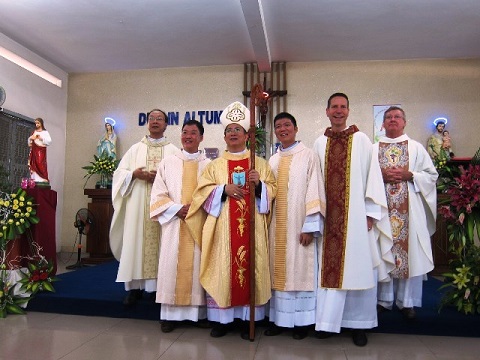
Thang deacon
He came to Australia in 2017, lived in the Formation Community at Cuskelly House, Blackburn, studied English as a second language at the Yarra Theological Union and, in 2018, studied the Spiritual Direction Course at the Heart of Life Centre. Since the beginning of 2019, he has been on the staff of the St Mary’s Retreat Centre, Douglas Park.
This is a photo from 2017 – more than a touch of the prophetic!

SOME LIGHT TOUCHES IN LOCKDOWN TIME
SOME LIGHT TOUCHES IN LOCKDOWN TIME
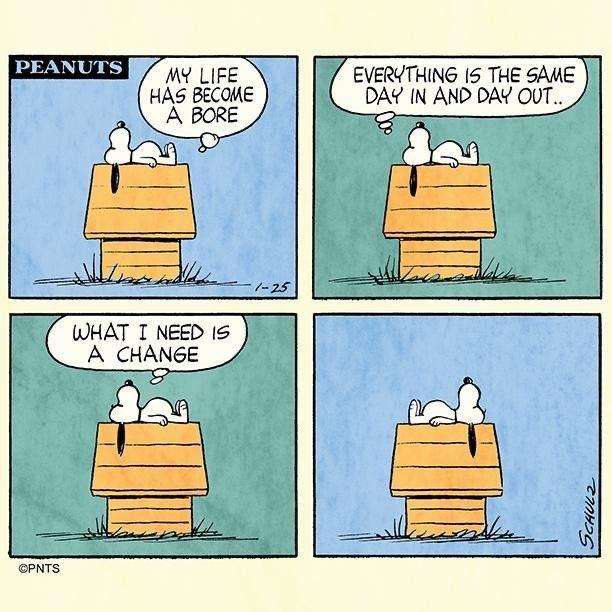
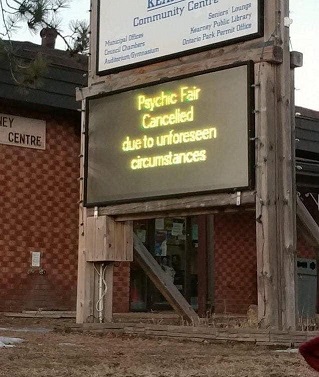
Have you been receiving cartoons in your email box? Video clips adapting songs: How do you solve a problem like Corona (The Sound of Music), Stayin' Inside (The Bee Gees) or Her Majesty singing We'll Meet Again? We are trying to cheer one another, even briefly, with humour about the pandemic and our concern. You may enjoy these - hope so!
And checking on ourselves


And the Easter Season, quarantine, lockdown and zoom
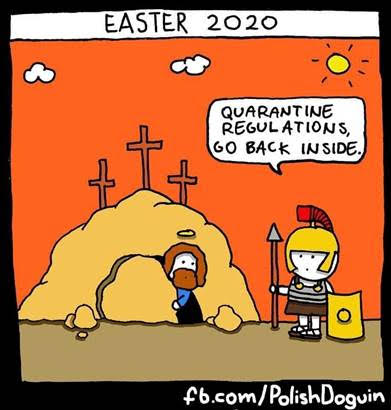
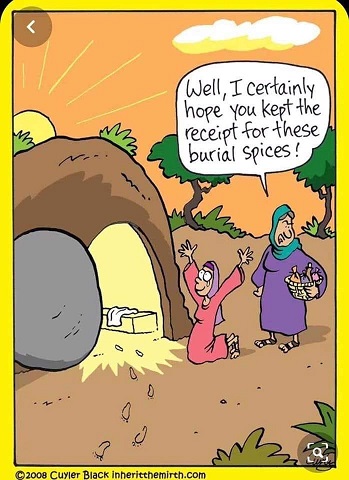

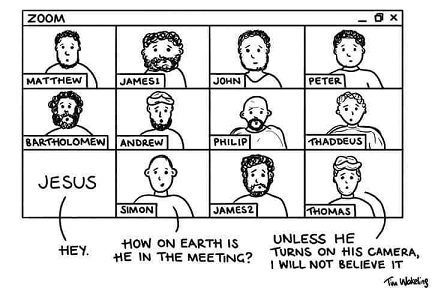
TO BE A REMEDY FOR THE ILLS THAT HUMANITY SUFFERS TODAY
AN OLSH PRAYER IN COVID-19 TIMES - AND A REFLECTION FROM ABZALON, MSC SUPERIOR GENERAL

TO BE A REMEDY FOR THE ILLS THAT HUMANITY SUFFERS TODAY
In times of the COVID-19, some of the more classic phrases that reflect our Spirituality and our MSC missionary tradition have become more current and relevant.
Today humanity is suffering a global evil, unfortunately it is not the only one, but the arrival of this virus shows us how other failures in our systems still remain unfixed, many of them hidden, made up, forgotten... This pandemic shows the wounds that humanity and the planet are suffering.
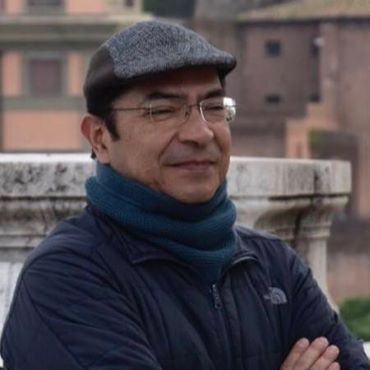
In spite of how devastating and complex this time of pandemic is, for us as MSC it should be a time to practice solidarity with the victims and at the same time to value the great gift we have in our MSC Charism and Spirituality: in times like the one through which we are living today all over the world "to be the heart of God on earth" and "to love like Jesus who loved with a human heart" are phrases that make more sense, especially when a pandemic comes and reveals our global vulnerability. Ironically this vulnerability is the consequence of global systems that do not place the human being at the center, rather economic and powerful interests.
The ‘Common Home’ and all of humanity are suffering from the inhumanity of our political and commercial systems, that are even capable of eliminating those whom society consider "disposable". Systems that take advantage, even of the pandemic, to show the world who has more power - this is disappointing.
There is an urgent need for people who truly love with a human heart, and we have the possibility of BEING AND DOING IT from the Heart of the People of God. Our people are suffering from many different "evils", one of them being the Coronavirus pandemic today. There are other "pandemics" that are subtle lies that are not even catalogued as such, but that continue to kill more people in the world, such as misery, inequality, human trafficking, abuse, violence, destruction of the common home, etc.
But today what can we as MSC learn from this time of pandemic? I believe that something has to change within us, there has to be a change of mentality and commitment to co-creating new attitudes towards life.
Avoiding magical and/or apocalyptic interpretations, this pandemic has shown us some important things.
- That all that we have is the present and this must be lived to the full. It is the recovery of TODAY, tomorrow is uncertain. And we who are co-dependent, at times, on our programs, agendas and securities, are today experiencing insecurity, feelings of limitation and abandonment to what is uncertain.
- We need to experience the God of Jesus, to return to that God, who according to the Gospels is not the "God of the Temple". If this terrible pandemic has taught us anything, it is that the God we must follow and to whom we need to commit ourselves, is not limited by the walls of our churches, or by rituals, or by traditions, or by customs, or even by culture. All that is wonderful and good but these days even the unimaginable or what we considered "non-negotiable" has been "cancelled". Today we have been challenged to live and experience the God who is present in the heart of each one, in the heart of the people and, indeed, in the heart of our social networks. He is the God of the tents, the God who walks with his people on their journey, as in the Old Testament. These presences of God are as alive as the living presence of Christ in the Eucharist.
- This is a time of changing methodologies, of changes in systems, some of them up to now considered untouchable, for example the liturgy. Today we are being called to pray and experience God within our homes or apartments, to celebrate life online, to deconstruct customs that have made us forget the centrality of the “Domestic Church”. We are now doing what Jesus really proposed in his time and which was therefore prophetic and authentic. As wonderful as the community celebration is in our worship spaces, today even the most famous Basilicas and Shrines around the world have had to change their practice.
- The pandemic had to come to help us reduce the level of clericalism that has affected us so much in our MSC religious life. Today it is no longer the big and massive events that concern us, but the awareness of being a parish community or another kind, the lowliness of empty and virtually connected temples. This experience poses great challenges that require much creativity especially in the economic field. The pandemic is showing us that it is not impossible to reach the same end in new and more creative ways
.
Anyway, we could continue to list so many other realities with which this time of pandemic has confronted us and that should lead us to make adjustments such as changing our mind-set and strengthening our sense of belonging. We are also being called upon to be different after this pandemic experience. Let us hope that we will soon see the end of this pandemic, which is neither the first nor the last in the history of humanity, but which is what our generation is being called upon to live through and face courageously.
May we return to Jesus in this time of pandemic, and continue struggling to be authentic followers of Jesus, with more clarity and independence, freed from any pre-conceived ideas about what following Jesus entails.
Today, more than ever, the People of God need MSC to be signs of Hope and Consolation, men imbued with the spirit of prayer and listening, capable of being present where people suffer and run risks. Present now in a virtual way, but still a prophetic presence. We are all called and committed to maintain the process of deconstruction of securities that the same coronavirus is making us live through. So that together we co-construct new ways and strategies of being and acting as MSC in the real world.
Abzalón Alvarado, MSC
ACKNOWLEDGING TERRIBLE HISTORY IN THE DOUGLAS PARK AREA: APPIN MASSACRE, 1816
ACKNOWLEDGING TERRIBLE HISTORY IN THE DOUGLAS PARK AREA: APPIN MASSACRE, 1816
In 1816 under the command of various military leaders three detachments were dispatched by Governor Macquarie to `inflict terrible and exemplary punishments` on the Aborigines of the Appin area.

Early in the morning of 17 April 1816 the military’s leader for the Appin area Captain Wallis and a number of his men came across a Dharawal men’s camp. They slaughtered the men who were mostly elders, cut off their heads and took them back to Sydney.
While Captain Wallis returned to Sydney the remaining men hunted down the local Aboriginal clan (Dharawal people). They found the camp where the women and children were staying. They shot and trampled them under their horses and drove them over the cliffs at Broughton Pass.
Governor Lachlan Macquarie's regiments were ordered to pursue and fire upon any Aboriginal people who attempted to escape apprehension as the soldiers scoured the settled and unsettled areas about Sydney.
The governor declared that Aboriginal men shot and killed during such encounters were to be hung from trees in prominent positions, to strike fear and terror amongst the surviving Aboriginal population.
For example, in his instructions to Captain Shaw of the 46th Regiment, Macquarie stated:
"On any occasion of seeing or falling in with the Natives, either in bodies or singly, they are to be called on, by your friendly Native Guides, to surrender themselves to you as Prisoners of War. If they refuse to do so, make the least show of resistance, or attempt to run away from you, you will fire upon and compel them to surrender, breaking and destroying the spears, clubs, and waddies of all those you take Prisoners.
Such Natives as happen to be killed on such occasions, if grown up men, are to be hanged up on trees in conspicuous situations, to strike the Survivors with the greater terror. On all occasions of your being obliged to have recourse to offensive and coercive measures, you will use every possible precaution to save the lives of the Native Women and Children, but taking as many of them as you can Prisoners."

Broughton Pass
The bodies of slain warriors were also decapitated, though in secret, and their heads sent off to museums in Europe.
Camps were created to house those people captured, whilst prisoners were transported to penal establishments such as Port Arthur and children were taken from families and tribes for re-education.
Gatherings of six or more Aborigines were declared illegal, customary practice was outlawed, as was the carrying of spears, and the non-Aboriginal civilian population was granted permission to shoot and kill those Aborigines who did not adhere to the tenets of the various proclamations issued by government.
The campaign - or "service" as Macquarie called it - was to be executed with "secrecy and despatch" (Organ 1989).
This brutal and barbaric action on the part of the authorities was also to make it clear to the rest of the population that the Aboriginal people were to be treated in a manner which would ensure the security of the ever expanding settlement.

TEXT SOURCE:
'Secret Service: Governor Macquarie's Aboriginal War of 1816' by Michael K. Organ - University of Wollongong
Available Online (with references) in PDF format: https://goo.gl/95qWHm
MARTYRS OF QUICHE
MARTYRS OF QUICHE
The beatification of our MSC Martyrs and 7 indigenous laity from Quiché (Guatemala) was confirmed for December 4, 2020.

The Prefect of the Congregation for the Cause of Saints will be the representative of Pope Francis to preside over the Beatification. The celebration will be held in Santa Cruz de Quiché, Guatemala.
Here are their stories:
It was engendered by poverty, racism, social differences, oppression, corruption, lack of work. It began with demonstrations, turned into confrontations between guerrillas and the army, grew into an "undeclared civil war" and led to a cruel persecution of the Catholic Church in several of the departments. Among them, the department of El Quiché in the west of the Republic of Guatemala suffered the most from this persecution. Not without reason did the bishop-poet Pedro Casaldáliga write:
Put on your wedding clothes,
You, the most martyr of all,
Santa Iglesia de Quiché.
Thousands of Catholics, especially catechists, were killed at that time. It was enough to have a Catholic bible or a rosary or to dedicate oneself to helping others for one to be classified as a guerrilla member, and, therefore a prisoner of death. Among the multitude of those killed for their faith, their living the Gospel, their service to the most needy and for trying to live like Jesus, ten people were chosen to begin their process of beatification. It was an arduous task that took more than 10 years. And we hope that they will not be the last. Three Missionary Priests of the Sacred Heart, pastoral agents of the diocese of Quiché, with seven of their catechists form the initial group of the martyrs of El Quiché.
Pope Francis decreed on January 23, 2020, that these three Missionaries of the Sacred Heart, together with seven of their Mayan catechists from El Quiché, could be counted among the number of the blessed of the Church.
These will be the first of the indigenous races, declared blessed in Central America.
We present some brief aspects of the martyrdom of these our brothers. May their example stimulate us to follow Jesus with ever greater joy and fidelity, revealing to us the love of God, for which these brothers; gave their lives.
The MSC Martyrs
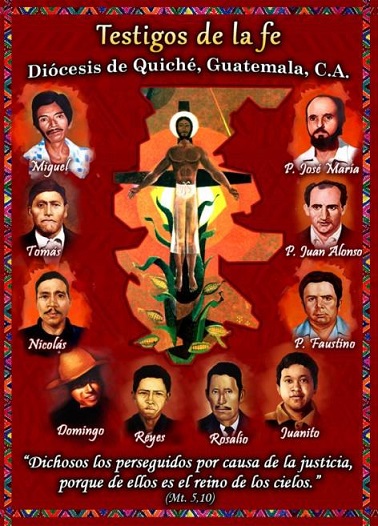
José María Gran Cirera.
You were warned. They had been told. They told him that he was in danger, that he was being persecuted, that they were looking for him. But, he said that he was in the same danger as the people in the village he served and that; he would not be left alone. A few months earlier he had told his older sister. "What would you think of a friend, if, in the moment of adversity he abandoned you?" And climbing the mountain with his friend and sacristan, Domingo, they were ambushed by the institutional forces of the Republic who shot them in the back and left them abandoned. He was 35 years old, and had only been in Guatemala for about five years, in the department of El Quiché, for "whose people I have taken a special affection and respect”. I thank God for being in Guatemala," he wrote to his family. This young missionary and priest from Catalonia, Jose Maria Gran Cirera, who affirmed that "my work is to make them aware of the true image of God as Father", lived his mission with a joyful and helpful giving of self until the end. It was June 4, 1980 when he fell riddled with bullets in his back.
Faustino Villanueva Villanueva.
The "secret anti-communist force", a hidden and effective paramilitary group, had decided to put an end to him. They were frightened by his action of awareness of human dignity and of the school and catechetical education that he was developing, moved by the Gospel and what this meant for their economic interests. One of his members, who was supposed to be a friend, repented and warned him to leave the municipality as soon as possible. But the Navarrese Faustino Villanueva Villanueva had clear ideas. He had written to his mother: "We cannot leave the people abandoned... the events we are living through, do not stop worrying and frightening us." Faustino was one of those who carried José María Gran's coffin on his shoulders, on his way to the cemetery in Chichicastenango he asked a question: "Who will be next?" And the next one was him, practically a month away. Some men in the evening asked to speak to him and he, being helpful as he was; with one of them he entered his office and a few minutes later a shot was heard and the men fled on a motorbike. The shot shattered his face. It was July 10, 1980. The motorbike was seen in the army barracks in Santa Cruz del Quiché. After a life given to the Indians, he was killed at the age of 49.
Juan Alonso Fernandez.
The commander of the post, told him that "it was disgusting for him to have a priest in front of him, that's why he spat on him, because it made him nauseous to see a priest." The Asturian Juan Alonso Fernandez endured a cruel torture that night. He said that "what they wanted was to kill me and I don't know how, they refrained from doing it, because I feel that they would have better killed me and not done what they did to me. In spite of everything, Juan did not give up. He celebrated the Eucharist in the village and went out to celebrate it in a neighboring village. There they waited for him, kidnapped him, tortured him again and shot him three times in the head. Days before, he had said, taking the crucifix that he always carried in his chest: "I became a priest because of this one, and if I have to die because of this one, here I am". It was February 15, 1981. He was 47 years old.
These three Missionaries of the Sacred Heart, priests at the service of the Diocese of Quiché in Guatemala, lived the spirit of their Congregation and knew how to assume truly number 12 of their Constitutions: "Trusting in the grace of God, we will be ready to give, if necessary, our life for them.
The Lay Martyrs of Quiche
Domingo del Barrio Batz. Born in Ilom in the municipality of Chajul. Father of three children. One of the sacristans of the parish of San Gaspar with the mission of accompanying the priests in their missionary journeys through the extensive parish. He worked as a translator, catechist and empirical nurse in the villages visited. He was the faithful companion of the priests and with Fr. José María Gran he was also their friend. When Fr. José María, warned of a possible attack, advised him to return by a longer route because he had family waiting for him and he loved them, Domingo replied that he would not be separated from him and "if anything happens to us, God willing... if they kill you they will kill me too, because we come together and return together. Don't be sad”. Going up to Xe Ixoq Vitz, on the way to Chajul, he was riddled with bullets by soldiers in an ambush together with Fr. It was June 4, 1980. He was 29 years old.
Tomás Ramírez Caba. He was born in Chajul. Married in second marriage to Rosa Caba. He lived for a time in the Ixcan. For more than twenty years he was the major sacristan of San Gaspar de Chajul. When the parish was left without priests due to the circumstances of the undeclared civil war, he was given the task of taking care of the great colonial temple and its outbuildings. He carried out his duty with constancy, working as a catechist, guiding the prayer of the faithful and working in the cooperative. The military wanted to occupy that space for their warlike interests and they always met with the opposition and strength of Thomas. He stated that "my commitment is to give my life here in the church... if I am killed here I would be happy". He always refused to hand over the keys of the convent and the church. Taking advantage of a gunfight in the village, the soldiers shot him in the back in the courtyard of the church and took over the temple and convent and put their center of operations there. It was September 6, 1980. He was 46 years old.
Nicolás Castro. With a birth certificate registered in Uspantán, he lived in Chicamán. He was a catechist, extraordinary minister of communion, health promoter, and cooperative member. When in that time of war; catholics were forbidden to meet in oratories and chapels, he proposed to meet in the mountains or at night in their houses. He was aware that, in that time of persecution, a special strength was needed that could only be found, in the Eucharist. He would go to San Cristóbal de Alta Verapaz to look for the Blessed Sacrament in the Parish and he would carry it in his backpack, between omelettes, so that his people could receive Communion. This is how he exposed his life on each trip. He was aware that he was going to be killed and did not give up his work. He was violently taken out of his house and in the courtyard of his home he was shot in front of his wife and children. It was September 29, 1980. He was about 35 years old.
Reyes Us Hernández, also known as Gaspar Us. Born in Macalajau, Uspantán. Leader, committed to social and health development with his people: school, road, cooperative, temple... in every work that the community undertook, he was there as an animator. Catechist and singer. A man in whom faith and works were truly united. "I am threatened by the army and it is probable that they will kill me, but, I am not afraid... I am well committed to the Church and I do not see that this is a crime". At night they went to look for him, he went out to the patio of his house and there they killed him, they shot him in the back and in the head, then they burned his house. It was November 21, 1980.
Juan Barrera Mendez. Bor n August 4, 1967 in Caser ío Potrero Viejo, El Tablón, Zacua lpa. He was one of the few graceful people who enjoyed school. That reality and his religious restlessness led him to accompany the catechists to read the Bible in their meetings and in the assemblies of the communities of Catholic Action. He took advantage of these opportunities to meet with companions of his age, to teach them the Word of God, to pray and to sing. In 1980 his canton was massacred by the army with the now traditional accusation that they were guerrilla members. Days before, in the face of the violence that he heard growing in El Quiché, he organized a prayer group that met at night to pray for peace. This group was accused of being guerrilla members and, action was taken against its participants. The soldiers took Juan for interrogation, tortured him and shot his body. Young Juan "repeated that we should not be afraid, that if we had to die it was for God. The Word of God does not end with death, we must go on. And he repeated again: "I am dying because I am working on the Word of God. I will give my soul in the name of the Lord. He was a little over 12 years old when he died in 1980.
Rosalio Benito. He was one of the first member s of the Catholic Action of Chinique, back in the 1940s. He was illiterate but learned all the prayers for all the circumstances of life and how to sing, thus, becoming a catechist and animator of the community. He took great pains to prepare the celebrations, especially the Eucharist. He was dedicated to his mission, he did not miss the opportunity to be formed by attending courses, even if he had to walk for long hours. He evangelized in the cantons around his own. With the first small group of catechists of Catholic Action, he made a promise of fidelity, until death. With great difficulties encountered in his long life, he fulfilled his promise. At the age of eighty he suffered a cruel death, being tortured and having his body thrown into a water well with other murdered companions. It was July 22, 1982.
Miguel Tiu Imul. He was born in Par r axtut, Sacapulas. He raised a lar ge family that he constantly invited to pray. He was a catechist and a man willing to help others. He told his family; "you should not be afraid of death, because when you tell the truth, people say that you are bad". He always told the truth. He was aware of being persecuted and in fact a few months earlier he had been imprisoned and tortured. At that time, any catholic, who committed himself to reality and denounced injustices, was considered a part of the guerrilla, as in the 60s and 70s they were called communists, because he fed the guerrillas, they said. He did not want to leave the canton. He claimed that "if I die, I die like Jesus. He was not a sinner and people said he was a bad man. I am a sinner. Certainly they announced to him that they were going to kill him, he never mentioned the name of the person who threatened him and said ; "God knows better, that he stays like this". That afternoon he went to see the cornfield where three of his children were keeping it. When he left his house, he was shot in the back. It was 6:30 p.m. on October 31, 1991. He was 50 years old.
Why were they killed? Years later, the UN Commission for Historical Clarification summarized the reason for the savage persecution of the Catholic Church in Guatemala, as follows: "The Catholic Church moved, in a very short time in the recent history of Guatemala, from a conservative position to positions and practices that, based on the Second Vatican Council (1962-1965) and the Medellín Episcopal Conference (1968), prioritized work with the excluded, the poor and the marginalized, promoting the construction of a more just and equitable society. These doctrinal and pastoral changes clashed with the counter-insurgency strategy, which considered Catholics as allies of the guerrillas and, therefore, part of the internal enemy, subject to persecution, death or expulsion". (1999)
Joaquim Herrera, MSC (Province of Central America and Mexico)
SOME NEWS ITEMS
SOME NEWS ITEMS
Leo Wearden has sent this item from Wadeye.
Tribute to Ted Merritt MSC
Frank Brennan SJ writes:
I am presently watching the funeral in Darwin of Brother Ted Merritt MSC, one of the greats, who ministered in the NT assisting remote Aboriginal communities for most of his life.
I placed this tribute on the Nightcliff Parish Facebook page for Ted:
A great man. The master of the wry understatement; a tireless worker; a fearless, persistent, practical advocate for the little guy; a man of simple faith with a big heart and absolutely no pretensions. He embodied all that's best and noble about the Australian MSCs. He worked in the kitchen when I was a boy at Downlands in the '60s and then we saw a lot of each other at the Daly and in Darwin over the years. May he rest in peace.
Tribute to Paul Stenhouse MSC
From Cardinal Pell: [‘Diary of an Innocent Man’, Tess Livingstone, The Australian, Tuesday April 14th 2020, Inquirer section, p. 9]
His deepest regret is the pain his ordeal caused his family and close friends. He was deeply saddened not to be able to visit Sydney priest Father Paul Stenhouse, the former editor of Annals magazine, when he was dying in November, after years of battling cancer. "He was a dear friend and learned priest. We need more like him.”
Condolences to Bishop Rochus Tatamai on the death of his mother.
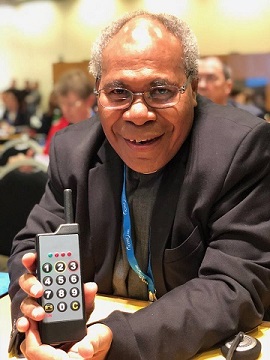
Dear one and all
It is within the joy of the glorious Resurrection of Jesus Christ and the sadness of a human heart that I officially announce that my mum Helena IaBarol (15.08.1942 - 12.04.2020) died this morning 730am at the Bishop's residrnce in Kavieng. She didn't have any health issues or illhealth medical history.
She was getting ready for morning mass and sat on the chair in the dinning room and died.
Thanks to you all for praying with me and my family for the repose of her soul. In fact Easter Monday was a beautiful and timely day for her to return to the Lord.
The Lord is truly Risen to Life and he is our resurrection and our eternal life. May he judge her mercifully and grant her eternal life.
Rochus Josef Tatamai MSC DD CSM
Bishop of Catholic Diocese of Kavieng
P.O.BOX 49, KAVIENG- NIP
Papua New Guinea
Seminar, God and Science, Chevalier Institue, previously advertised, now a Webinar, details below.

IN MEMORIAM, TED MERRITT MSC, REQUIEM MASS AND FUNERAL AT WADEYE
IN MEMORIAM, TED MERRITT MSC, REQUIEM MASS AND FUNERAL AT WADEYE
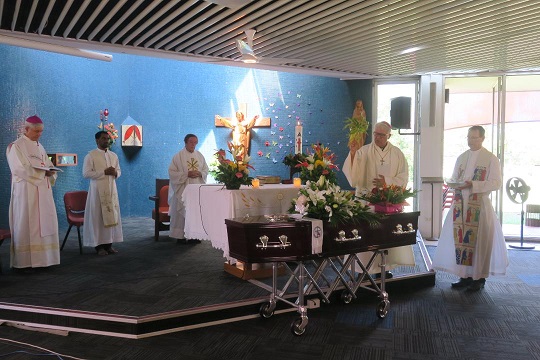
The first MSC Requiem in this covid-19 era. It was filmed and the ceremony is available on YouTube.
With thanks for Malcolm Fyfe for texts and Peter Hendriks for the photos.
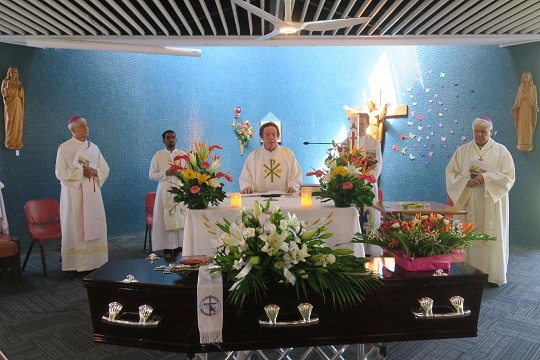
Greeting.
Dear Friends and all of you who are prayerfully here in spirit but wishing you were actually present with us this morning: I mention in particular Brother Ted Merritt’s sister Margaret and husband Des, their family members and other relatives down in Brisbane, as well as many friends watching from a range of places across Australia.
We welcome you to St Paul’s Church, Nightcliff.
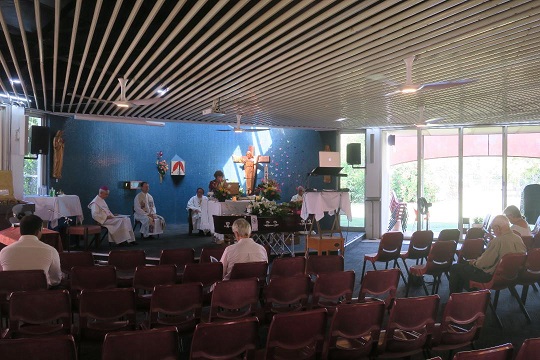
My name is Father Malcolm Fyfe and celebrating Brother Ted’s Requiem Mass with me are two other Missionaries of the Sacred Heart, parish Priest Father Peter Hendriks and his assistant Father Barthalomai. I want to acknowledge and thank our Diocese of Darwin Bishop, Charles Gauci, for presiding at this liturgy and Emeritus Bishop Eugene Hurley for additionally gracing this occasion by his presence.
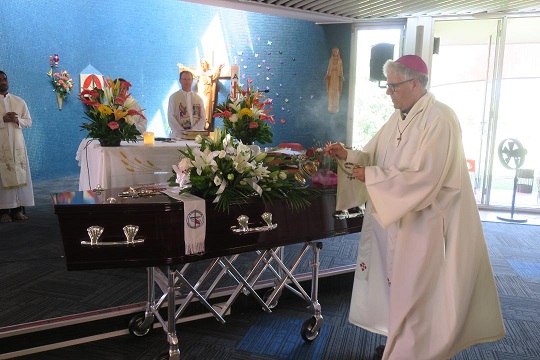
A very limited but representative group of 5 are with us as we celebrate this Mass: Sister Mary Stevens, a long standing friend and co-worker with Brother Ted, representing also the Daughters of Our Lady of the Sacred Heart, Damian Legg, from the St Vincent de Paul Nightcliff Conference, two of Brother Ted’s close friends, Joan Halvorson and Peter Liddle and lastly Michael Thekkayil, with whose family Brother Ted had become very close, having a special and affectionate bond with Michael and Christina’s two charming children. There are many others who might well have been part of this select group, such as Tony Sully and Marist Brother Daniel Hollamby, to name just two very familiar faces at the MSC Centre, The Ranch, where Brother Ted lived. They were both part of the roster keeping watch during his final nights and days. A number of people, including all of those actually present, offered NOT to come because of the restricted number able to be present.

Had other people been free today to attend in person, I doubt if we would have been gathering here at St Paul’s. We would have needed the Cathedral to accommodate all those who would have wanted to be present.
You are with us in spirit as we continue with this Eucharistic celebration.
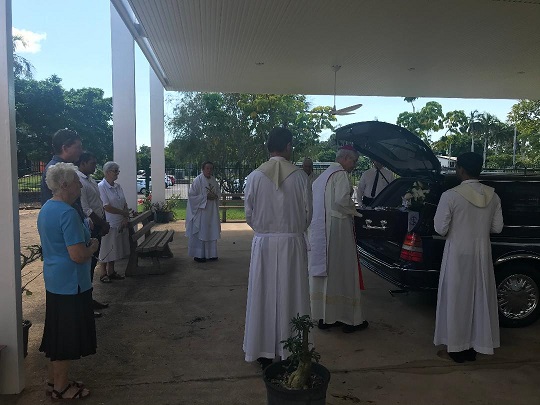
Funeral Mass Homily
“In him, who rose from the dead,
Our hope of resurrection dawned.
The sadness of death gives way
To the bright promise of immortality.
Lord, for your faithful people life is changed, not ended.
When the body of our earthly dwelling lies in death
We gain an everlasting dwelling place in heaven.”
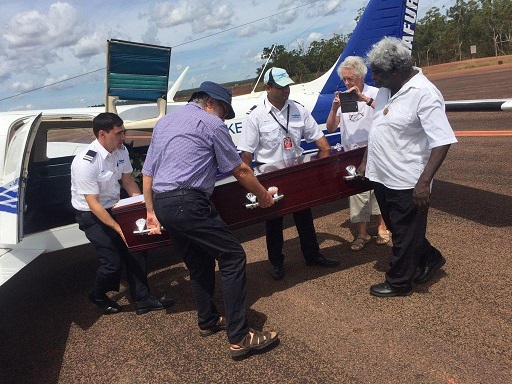
My dear friends, as we link up together as best we can this morning to commend to our loving God the soul of a Missionary of the Sacred Heart, Brother Edward Patrick Merritt and to bless and honour his mortal remains, the words I have just quoted, from one of the Requiem Mass Prefaces, sum up for us our essential Christian belief in what happens to us when our life on this earth comes to an end. This belief is reinforced by St Paul’s statement in his letter to the Romans (Chapter 8): “If the Spirit of him who raised Jesus from the dead has made his home in you, then he who raised Christ Jesus from the dead will give life to your own mortal bodies, through his spirit living in you.”
In other words, the victory of Jesus over death and sin that we have but a few days ago celebrated, is the model and pattern of our own destiny. We too, are to pass through death to life in Christ Jesus and see God face to face for all eternity. And the sorrow and sense of loss that we naturally experience at the death of someone we have admired and loved, give way to a celebration of his personal gifts and of all that he achieved throughout a long and dedicated life.
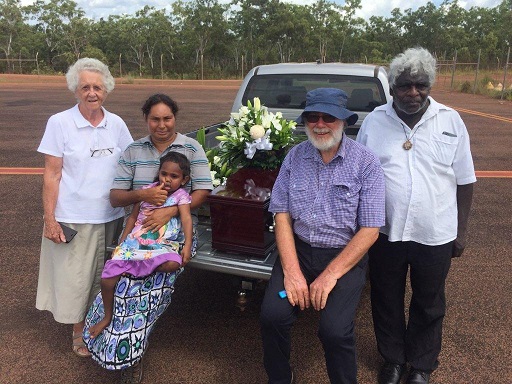
And so, though this morning, family, confreres and friends are mourning Brother Ted’s departure from this life, we can be more intent on thanking God for all the gifts he endowed Brother Ted with and in recalling how he used these gifts for the good of others.
As we celebrate this Requiem Mass to commend his soul to God, I will limit myself to recalling just a few of the salient features from the life story of this quite unique Religious Brother.
Edward Patrick Merritt was born in 1928 at Corinda, a suburb of Brisbane. Even as a Secondary School student, young Ted felt a call to a religious vocation but it was only when he was 25 years of age that he took ‘a leap in the dark’, as he put it, and travelled down to Douglas Park, south of Sydney, to join the Missionaries of the Sacred Heart as a Brother. Up till that point he had been working in the motor industry, a job that would stand him in good stead in his subsequent missionary labours.
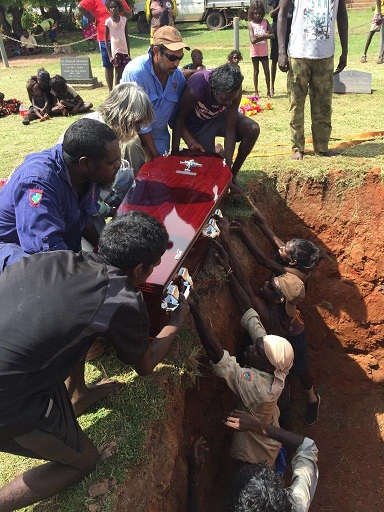
Brother Ted made his first commitment as a religious brother mid-1954. Subsequently he worked as a gardener at Douglas Park for two years, in the office of the MSC publication “The Annals” for two years and in our boarding Colleges for a similar period. Again, this range of tasks, together with the skills he had earlier acquired in the workforce, prepared him for his life on mission stations in the Northern Territory.
Missionary life in the 60’s and 70’s was tough and at times, harsh in the extreme. Our Northern Territory missionaries in those years, were expected to be self-reliant men of grit and perseverance, capable of enduring isolation and an exacting lifestyle, with expertise in sharing the faith, along with the practical skills needed to cope with almost any contingency.
It was on June 30, 1966, that Brother Ted arrived in the Northern Territory to begin more than half a century of dedicated commitment to the life and ministry of the Diocese of Darwin in a special engagement with the Indigenous and the marginalised.
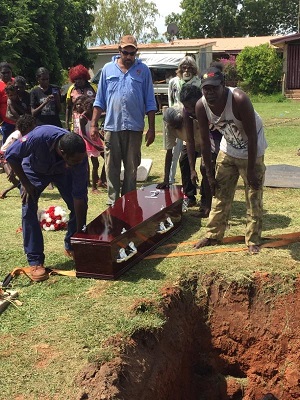
From 1960 onwards, Brother Ted lived and worked for significant periods on all of our NT Mission stations: at Bathurst Island, at Wadeye, at Woodycupaldiya where he lived for a number of years in a demountable, at Daly River and at Santa Teresa, 80 km south east of Alice Springs - at times the resident mechanic, at times the accountant or the town clerk, and then at the age of 60 he learnt how to fly a plane and acquired his pilot’s licence. It is impossible in this short homily to recall in any detail the day-to-day challenges faced-up to, the dramas that occurred, the simple joys of life experienced, the many relationships forged.
In 2001 Brother Ted withdrew to Darwin, living at the MSC Centre, commonly known as “The Ranch”. It was not to be a retirement but a new lease of life, dedicated to the St Vincent de Paul Society, at the beck and call of innumerable people on the margins of society, with their many and various needs and their at times importunate requests for immediate help. Brother Ted matched these activities with repairs and maintenance tasks at The Ranch, with an energy level that people twenty years younger than him could well have been envious of.

For the last 15 years I lived at the MSC Centre in Nightcliff with Brother Ted and witnessed at first hand his manner of life and his unswerving loyalty to his religious vocation lived out with gospel simplicity.
I used to think that Brother Ted would live to be 100 years of age. In fact, several times I warned him he should have something prepared to say at MY funeral Mass. Admittedly a risky commission to give to someone who had lived in the same community with me for so long! So, what happened over the space of two weeks was totally unexpected. That Saturday morning when he started to feel unwell, with the pain increasing each hour… Brother Ted trying to downplay it, but within hours, the ambulance was called and the first aid people did all they could to ease the pain before he was taken to the Emergency Department. Next morning, he underwent a quite massive operation and thereafter spent most of his remaining days in the ICU. I want to pay tribute here to the care that he received from the doctors and nurses at the Royal Darwin Hospital. From time to time we thought Brother Ted would somehow manage to overcome the forces that were pulling him down, but it was not to be.
A few days before a possible transfer to the Darwin Hospice, a Palliative Care nurse was plying him about a tedious range of questions to be filled in on the Hospice Forms. Surprisingly one of the questions was regarding what had been the focus of his life. Brother Ted replied unhesitatingly “Eternal Salvation and the Service of the Poor”. What a privileged moment to be present at that interview!
A few hours after he was transferred to the Hospice on Holy Thursday, he simply stopped breathing. Two of his very close friends were at his side, Peter Liddle and Joan Halvorson who are both here this morning.
I want to extend my personal condolences, the condolences of the Darwin diocese and those of the Missionaries of the Sacred Heart to Brother Ted’s younger sister Margaret and her husband Des, to their children and to all his other relatives, most of them down in Brisbane. They have been in frequent touch with us throughout these last couple of weeks. Needless to say, the poignancy of these recent events has only been heightened by the distancing restrictions we currently have to work under. I also want to extend our condolences to Brother Ted’s many friends and clients, many of whom will now be wondering who to turn to with their needs.
I also want to mention my fellow MSC priests and brothers, especially those ministering in the Darwin diocese. Our NT MSC Superior, Father Leo Wearden at Wadeye, Father Peter at Daly River, Fathers Pat Mara and Danh Doan on the Tiwi Islands and of course my concelebrants here at the altar. All of these men will miss Brother Ted’s fellowship and his ever ready willingness to assist them in any way needed.
In particular, I want to mention Brother Herman Kooyman, who is in lockdown at the Pearl Aged Care Facility. He would love to be here this morning to give witness to how much and how often Brother Ted did everything he could to make life a little more tolerable for him. Brother Herman will miss Brother Ted very dearly indeed.
So thank you, Brother Ted, for your enormous contribution to the life and mission of the Church in the Northern Territory, with special emphasis on helping the Indigenous and the marginalized.
There is an ancient and well-known prayer called the Anima Christi, a prayer addressed to Christ in the Eucharist and generally recited after receiving Holy Communion. It is a beautiful prayer that Brother Ted was familiar with. It begins with the words:
Soul of Christ, sanctify me; Body of Christ, save me
Water from the side of Christ, wash me
Passion of Christ, strengthen me.
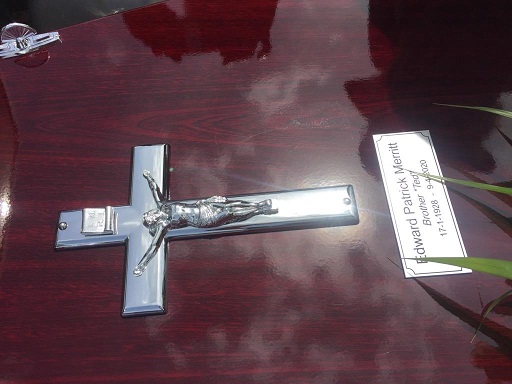
Then looking ahead to the fragility and mortality of the life of each one of us, it continues
O good Jesus, hear me...
In the hour of my death call me; and bid me come unto You
That with your Saints I may praise You; Forever and ever, Amen.
“In the hour of my death call me and bid me come unto You.”
In the hour of Brother Ted’s death, we can be sure it was Jesus who called him and bade him to come to Him, so that with all the Saints he could be with Him and praise Him forever.
As we continue now with the celebration of the Mass, we can be sure that Brother Ted, who as a Missionary of the Sacred Heart was so faithful to his religious commitment and to the teachings of Jesus, so devoted to the presence of Christ in the Eucharist and always ready to help the neediest of God’s people, is already enjoying everlasting life, peace and light in the Kingdom of God.
Malcolm Fyfe msc
16.04.2020
